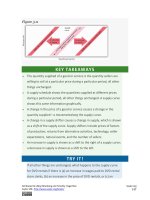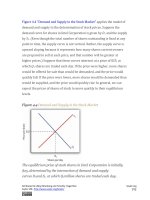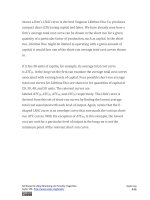Authors libby rittenberg 110
Bạn đang xem bản rút gọn của tài liệu. Xem và tải ngay bản đầy đủ của tài liệu tại đây (290.73 KB, 1 trang )
Another way of saying this is to say that the curve gets steeper as we move
from left to right; the absolute value of its slope is increasing. Producing
each additional unit of the good on the horizontal axis requires a greater
sacrifice of the good on the vertical axis than did the previous units
produced. This fact, called the law of increasing opportunity cost, is the
inevitable result of efficient choices in production—choices based on
comparative advantage.
The production possibilities model has important implications for
international trade. It suggests that free trade will allow countries to
specialize in the production of goods and services in which they have a
comparative advantage. This specialization increases the production of all
goods and services.
Increasing the quantity or quality of factors of production and/or
improving technology will shift the production possibilities curve outward.
This process is called economic growth. In the last 50 years, economic
growth in the United States has resulted chiefly from increases in human
capital and from technological advance.
Choices concerning the use of scarce resources take place within the
context of a set of institutional arrangements that define an economic
system. The principal distinctions between systems lie in the degree to
which ownership of capital and natural resources and decision making
authority over scarce resources are held by government or by private
individuals. Economic systems include market capitalist, mixed, and
command socialist economies. An increasing body of evidence suggests
that market capitalist economies tend to be most productive; many
Attributed to Libby Rittenberg and Timothy Tregarthen
Saylor URL: />
Saylor.org
110









